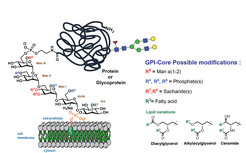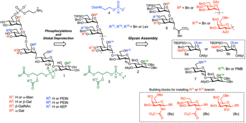Synthese von Glykosylphosphatidylinositole (GPIs)
Glycosylphosphatidylinositols (GPIs) are complex glycolipids ubiquitous in eukaryotic cells. They are present as free glycolipids or attaching proteins to the outer leaflet of the cell membrane. The GPIs structure comprises a phosphoethanolamine unit, a phospholipid, a conserved pseudo-pentasaccharide core, and cell- and tissue-specific modifications (Figure 1).

Converegent strategy for the synthesis of GPIs: During the past years, our group developed a synthetic strategy to obtain homogenous GPIs and GPI-derivatives. We established a convergent synthetic strategy and optimized the conditions to obtain several biologically relevant GPIs from protozoa and mammalian cells, having linear and branched structures. The strategy involves the assembly of a set of common building blocks with orthogonally protecting groups and the late-stage introduction of specific modifications (Figure 2). Using this strategy, we efficiently assembled the GPIs and GPI-fragments from Plasmodium falciparum, Trypanosoma brucei, Trypanosoma congolense, Toxoplasma gondii, and from the human glycoprotein CD59.

|
Figure 2. General convergent strategy for the synthesis of GPIs. The core structure is showed in black. Additional glycans (red), phosphorylation (blue) and lipid chains (green) are depending of the GPI’s origin. |



